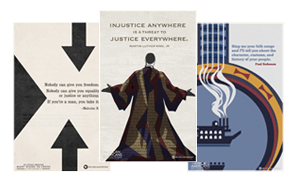Resistance to Slavery ~ Lesson Plan
Lesson Overview
(Click here for a printer-friendly version of this lesson).
LESSON TITLE: Successes and Failures in Resistance to Slavery
GRADE LEVEL: 6-10
TIME ALLOTMENT: One 45-minute session
OVERVIEW
In this lesson, students examine efforts made by African slaves in the New World to resist slavery. The lesson would ideally follow a unit on the colonization of the New World. Students begin by reviewing the geography of the trans-Atlantic slave trade and identifying colonies held by different European powers around the year 1750. They then view segments of the PBS series The African Americans: Many Rivers to Cross to compare several attempts at resistance and revolt. They discuss factors that may have contributed to the success and failure of the slaves’ struggles toward freedom. Lastly, students discuss more creative and subtle methods of resistance to the dehumanization imposed by slavery, such as the maintenance and creation of unique cultural traditions. They learn that many of these cultural traditions show evidence of connection across different locations in the Americas.
SUBJECT MATTER: Social Studies
LEARNING OBJECTIVES
After completing this lesson, students will be able to:
- Identify areas of the New World that were held by England, Spain, and France circa 1750;
- Map the direction and geographic distribution in the Americas of the transatlantic trade in African slaves;
- Name several distinct types of resistance to slavery;
- Describe factors that contributed to the success or failure of African slaves’ efforts at rebellion and revolt in the 17th and 18th centuries;
- Explain how traditions and cultures in the Americas evolved from a mixture of influences from Africa the Americas.
STANDARDS
From the Common Core Standards: English Language Arts
Common Core Standards, now adopted in over 40 states, are designed to help educators prepare students for success in college and careers by focusing on core knowledge and skills. The English Language Arts standards reflect the need for young people “to read, write, speak, listen, and use language effectively in a variety of content areas” including history/social studies. This curricular resource developed to accompany The African Americans: Many Rivers to Cross aligns most closely with the following Common Core Standards:
RH.6-8.1 Cite specific textual evidence to support analysis of primary and secondary sources.
RH.6-8.2 Determine the central ideas or information of a primary or secondary source; provide an accurate summary of the source distinct from prior knowledge or opinions.
RH.9-10.1 Cite specific textual evidence to support analysis of primary and secondary sources, attending to such features as the date and origin of the information.
RH.9-10.2 Determine the central ideas or information of a primary or secondary source; provide an accurate summary of how key events or ideas develop over the course of the text.
From the National Standards for United States History for grades 5-12, available online at http://www.nchs.ucla.edu/Standards/us-history-content-standards:
United States Era 2
Colonization and Settlement (1585-1763)
Standard 1: Why the Americas attracted Europeans, why they brought enslaved Africans to their colonies, and how Europeans struggled for control of North America and the Caribbean
Standard 1A: The student understands how diverse immigrants affected the formation of European colonies.
Grades 5-12: Trace the arrival of Africans in the European colonies in the 17th century and the rapid increase of slave importation in the 18th century. [Reconstruct patterns of historical succession and duration]
Standard 3: How the values and institutions of European economic life took root in the colonies, and how slavery reshaped European and African life in the Americas
Standard 3C: The student understands African life under slavery.
Grades 5-12: Analyze the forced relocation of Africans to the English colonies in North America and the Caribbean. [Appreciate historical perspectives]
Grades 7-12: Analyze overt and passive resistance to enslavement. [Analyze cause-and-effect relationships]
From the National Standards for World History for grades 5-12, available online at http://www.nchs.ucla.edu/Standards/world-history-standards:
World History Era 6
The Emergence of the First Global Age, 1450-1770
Standard 4
Economic, political, and cultural interrelations among peoples of Africa, Europe, and the Americas, 1500-1750.
Standard 4B: The student understands the origins and consequences of the trans-Atlantic African slave trade.
Grades 5-12: Describe conditions of slave life on plantations in the Caribbean, Brazil, and British North America and analyze ways in which slaves perpetuated aspects of African culture and resisted plantation servitude. [Appreciate historical perspectives]
MEDIA COMPONENTS
Video
The African Americans: Many Rivers to Cross, selected segments.
Access the video segments for this lesson at the Video Segments Page.
Segment 1: St. Augustine, Florida. Runaway slaves who fled to St. Augustine, Florida, were granted freedom by the Spanish for political reasons.
Segment 2: Hutchinson’s rebellion. Hutchinson’s rebellion (also known as the Stono rebellion), was a slave revolt that started outside Charleston, SC, but ultimately failed.
Segment 3: St. Domingue. The slave revolt in St. Domingue (now Haiti) led to the world’s first black republic.
Segment 4: Creative resistance. Despite the efforts of Europeans to erase the identities of slaves, they created a new culture.
Segment 5: Haitian Carnival. Culture and ideas passed throughout the Black Atlantic and continue to inflect our traditions.
MATERIALS
For the class:
- Computer, projection screen, and speakers (for class viewing of online video segments and 1750 map)
For each student:
- “The Americas circa 1750” Student Organizer
PREP FOR TEACHERS
Prior to teaching this lesson, you will need to:
Preview all of the video segments used in the lesson. Prepare to watch them using your classroom’s Internet connection.
If you plan to project the “Americas circa 1750” map for the class, locate it here: http://www.davidrumsey.com/luna/servlet/s/82bfdc (Copyright 2006, Rumsey collection).
Using a social bookmarking tool such as del.icio.us or diigo (or an online bookmarking utility such as portaportal) will allow you to organize all the links in a central location.
Print out and make copies of the “Americas circa 1750” Student Organizer for each student.
Find educational resources related to this program - and access to thousands of curriculum-targeted digital resources for the classroom at PBS LearningMedia.
Visit PBS Learning Media






